Let’s be honest — garage doors don’t usually get the love they deserve. They’re big, flat, and often ignored when it comes to exterior design. But here’s the kicker: a simple upgrade like garage door molding trim can change your home’s whole vibe.
It’s one of those small shifts that quietly transforms everything. A pop of definition here, a clean edge there — suddenly your garage doesn’t just hold cars. It makes a statement.
Whether you’re into crisp colonial edges or more of that cozy cottage charm, molding trim is a flexible, budget-friendly way to boost curb appeal fast.
And beyond the look, it protects too — from weather, pests, or, well, the occasional enthusiastic backing out. Trim’s like the frame on a great painting. Doesn’t steal the show, but try picturing the masterpiece without it.
Why Garage Door Molding Trim Matters
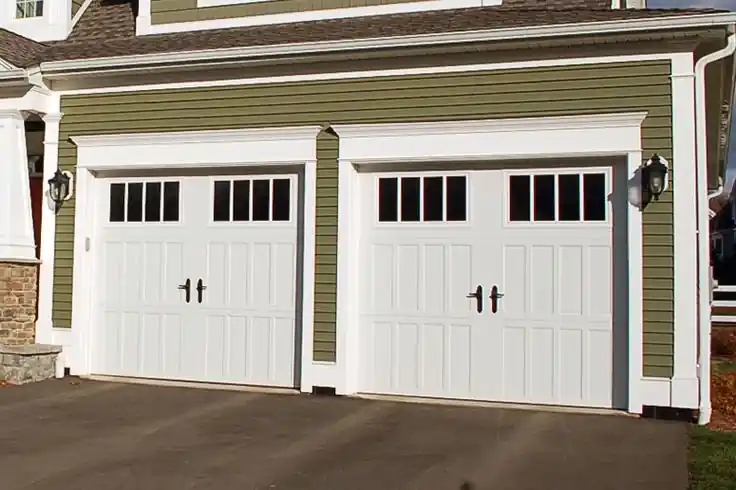
The trim around your garage door? It’s not just decorative fluff. It’s a functional, style-shaping piece of your exterior — and you’d be surprised how much it can do. Whether you’re tackling a garage door replacement or just curious about fresh garage door molding trim ideas, here’s why this little detail deserves a second look.
1. First Impressions Count. Like it or not, people notice the garage. It’s big, usually front-facing, and sets the tone for your home’s style.
2. Practical Protection. The right trim — think weatherstripping seals, PVC stop molding, or even a garage door seal bottom strip — keeps out rain, wind, critters, and drafts. That’s money saved on energy bills, by the way.
3. Style Match or Statement? From classic colonial to bold black-on-white contrast, garage door molding trim design gives you the flexibility to either blend in or stand out. Choose wood for a warm, custom look — or low-maintenance PVC if you’re more of a “set it and forget it” type.
Quick Comparison Table: Trim Materials at a Glance
| Material | Look & Feel | Maintenance | Cost Range | Best For |
|---|---|---|---|---|
| Wood (Cedar, Walnut) | Warm, rich, classic | Medium | $$ | Traditional & rustic homes |
| PVC Trim | Clean, modern | Low | $–$$ | Low-maintenance exteriors |
| Composite | Wood-look, durable | Low-Med | $$ | Weather-exposed garages |
| Faux Stone/Brick | Luxurious, textured | Low | $$$ | High-end curb appeal upgrades |
Pro Tip: If you’re worried about water damage or pest protection, look for Universal Adhesive Backed Garage Door Rubber Seal Strips or a Garage Door Draft Stopper during install. These sealants help your beautiful trim last longer.
1. Classic Colonial Trim: Timeless Appeal for Traditional Homes
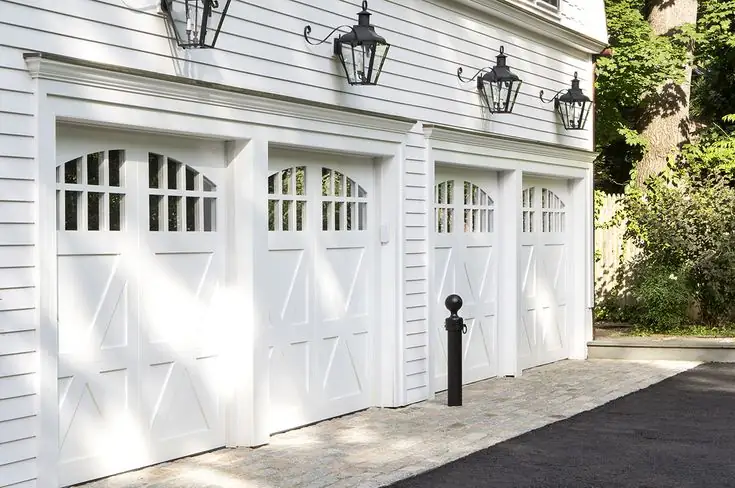
Here’s where it gets a bit nostalgic — the clean lines and wide, symmetrical borders of classic colonial garage door trim just hit differently. It feels intentional. Familiar. Kind of like walking up to your grandparents’ house, only with better paint.
What is Colonial Style Trim?
Colonial trim is big on balance and grace. It usually features layered elements, like crown molding on top or thick casing around the sides — often painted in crisp white or coordinating tones that tie into shutters or entry doors. Some versions use component brick mould or Step Rabbit profiles to add depth without overwhelming the space.
Think symmetry. Wide framing. Elegant proportions. A garage door molding trim that tells the world, “Yes, I do have matching flower beds.”
Best Materials for Colonial Trim
You’ve got options — and honestly, both wood and PVC can work beautifully here.
- Wood (especially Cedar Molding or Dark Oak Molding) gives a rich, textured finish.
- Low-maintenance PVC trim kits are easier for DIY installs, especially with modern clip-on seal systems.
Finishing Tip: Try Colored Trim Nails in a coordinating tone (Sherwin Williams has good exterior palettes) for a polished finish.
2. Craftsman Style Trim: Bold Lines and Rustic Character
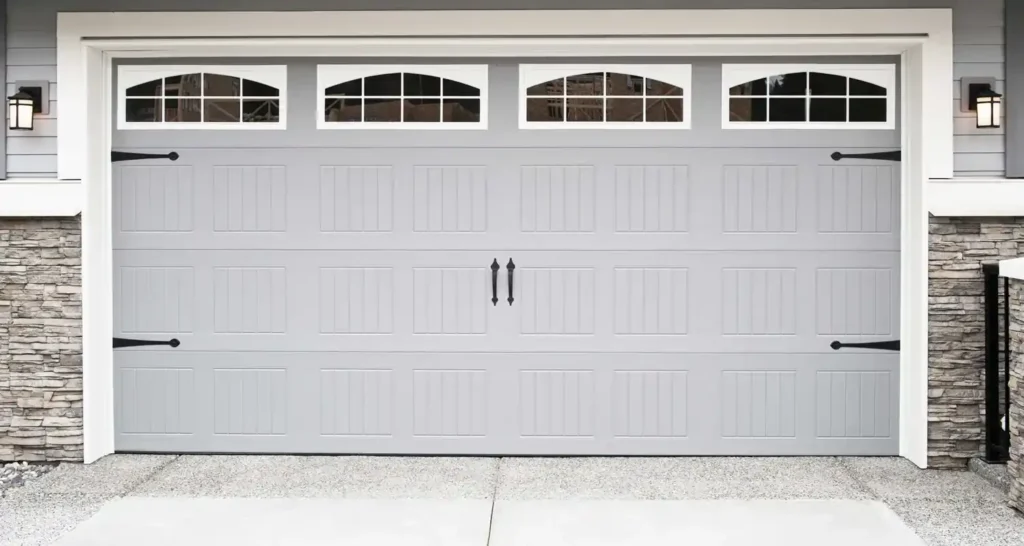
If colonial is the clean-cut suit, craftsman garage door trim is the comfy flannel shirt with hand-carved buttons. It’s bolder, woodier, and feels like it belongs in homes with front porches and warm porch lights. This is one of those garage door molding trim ideas that feels both rugged and well thought out — like someone really cared when they picked it out.
Defining Craftsman Trim Features
You’ll know it when you see it. Here’s what sets it apart:
- Thick side casing with a heavy top cap
- Layered profiles that create a shadow effect
- Strong horizontal emphasis — it’s all about those lines
These designs pair beautifully with bungalow-style homes, wood-panel siding, or garage doors with Tongue & Groove detailing. The style works best with doors that have c-channel guides or exposed hardware (those big black hinges you sometimes see on faux carriage doors? Yup, those).
Best Paint Colors and Material Pairings
Craftsman trim loves nature — and the colors that come with it. Think:
- Sage green, clay, warm taupe, or deep brick red
- Materials like driftwood molding, cedar, or even dark oak molding
- Combine with garage door seal top and sides for that snug, weather-ready look
Pro Tip: Want to level up your curb appeal? Try matching the trim color to your porch railings or front door accents. This creates visual harmony — without being overly matchy-matchy.
Where to Use This Style
- Perfect for: Craftsman homes, cottages, mountain cabins
- Great pairings: Stone veneers, wood shingles, farmhouse lighting
- Avoid if: You’ve got a sleek, modern steel garage door (but hey, rules are flexible)
If you’re exploring rustic garage door ideas that still feel polished, this might be your match. Even modern structures like the Kendall Center Green Garage in Cambridge show how thoughtful trim work — whether rustic or sleek — can elevate a space. And yes, it’s DIY-friendly if you’ve got the right tools, especially with a garage door trim kit that includes pre-cut angles and installation guides.
3. Modern Minimalist Trim: Sleek and Subtle Lines
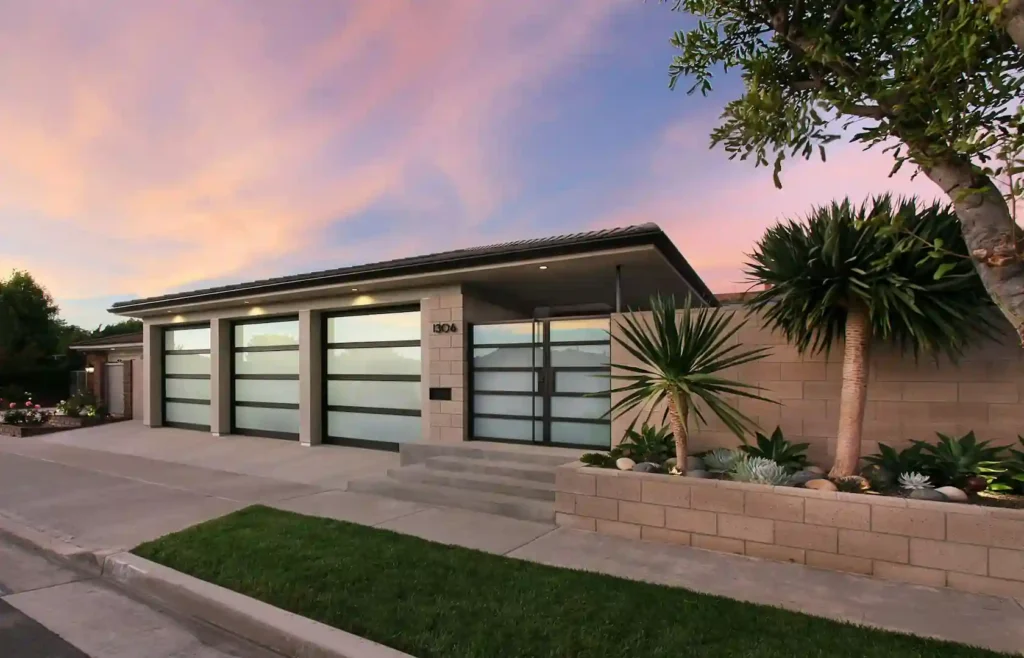
Okay — let’s shift gears. Clean. Crisp. Quiet. That’s the aesthetic here. Modern garage door trim is all about subtlety. You may not even notice it at first glance… and that’s kind of the point.
Key Traits of Modern Garage Trim
- Flat profiles with no decorative elements
- Hidden fasteners or minimal attachment points
- Usually painted in neutral tones like charcoal, matte black, or warm grays
If your home has steel rolling garage doors, smooth siding, or even a mix of stucco and concrete, this trim style fits right in. It’s about structure, not ornament. And it’s often used in conjunction with Rigid Vinyl Reverse Angle Jamb Seals or Universal Adhesive Backed Garage Door Rubber Seal Strips for a super-tight, energy-efficient finish.
Material Choices for a Clean Look
Here’s a breakdown of your best bets:
| Material | Look | Benefits | Drawbacks |
|---|---|---|---|
| Aluminum trim | Sleek | Lightweight, modern, rust-proof | Dents easily |
| Low-maintenance PVC | Clean | Doesn’t rot, easy to install | May lack warmth or texture |
| Composite | Balanced | Weather-resistant, subtle grain | Slightly more expensive |
Installation Tip: Use garage door track retainer kits to ensure that weather stripping seals stay snug and hidden — they help create that seamless, tight-border effect that minimalists love.
Visual Examples and Placement
Modern homes often use vertical trim lines to create height — especially if the garage door is wide or positioned front-and-center. A slim trim piece around the edges, paired with a dual flap top seal or impact buffer sealing weatherstrip, creates both function and form.
Want a garage that blends into the siding but still looks sharp? This style gets you there — quietly.
4. Decorative Header Trim: Add a Grand Entrance Feel
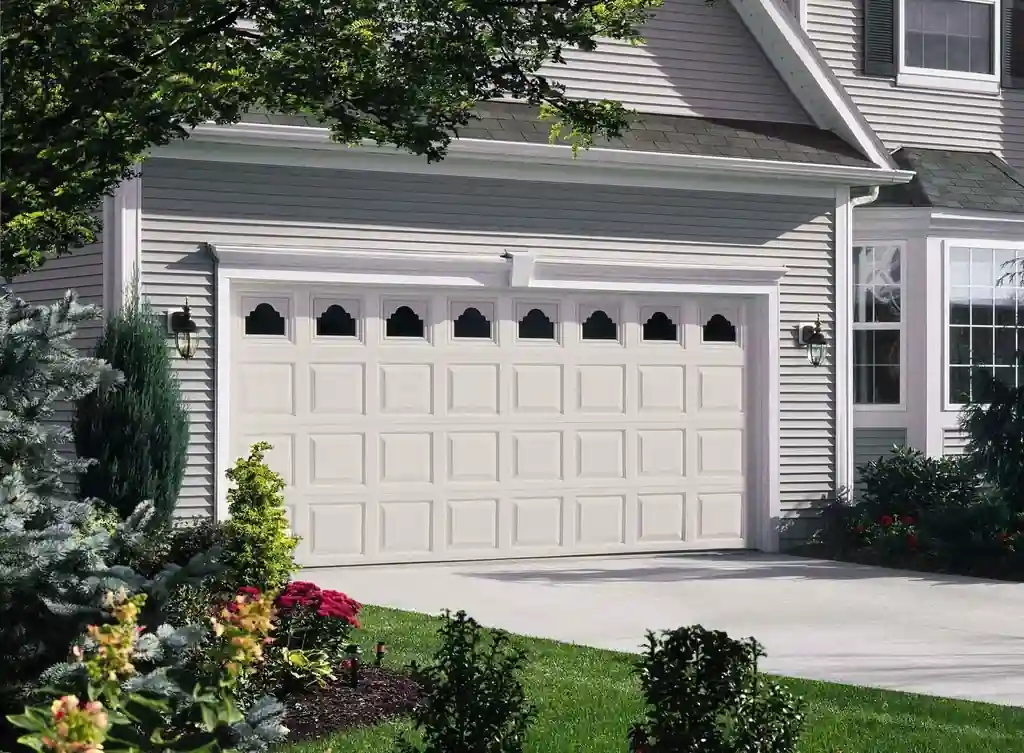
You know that feeling when you drive past a house and the garage just… stands tall? There’s a quiet elegance to it. That’s the magic of decorative garage door molding trim molding — especially header trim. It’s like giving your garage a crown.
Even public structures like the Kendall Center Yellow Garage in Cambridge use bold trim accents to add a sense of stature and style — proving that a well-framed entrance can make a big impression anywhere.
What is Header Trim and Why Use It?
Header trim is the molding piece placed above the garage door — sometimes arched, sometimes straight, but always elevated in feel. It draws the eye upward, making the entire structure seem taller and more intentional.
Here’s what it adds:
- A sense of balance to wide garage door openers
- A formal “top frame” to visually complete the garage door molding trim
- Space for outdoor lighting, signage, or house numbers
If you’re after that garage door frame upgrade that feels grand but not overly ornate, this is a smart place to start.
Styles of Header Trim
Depending on your overall exterior design and garage door element, header trim can take many forms. A few popular styles include:
- Arched header trim with faux keystones
- Layered molding that mimics traditional door casing
- Straight, thick beam-like designs for modern or craftsman homes
Some even integrate a Garage Door Seal Top and Sides, combining design with weatherproofing.
DIY Tips & Installation Ideas
- Foam crown kits: Lightweight and affordable.
- Pre-milled cedar or PVC trim kits: Great for a custom fit — easy to stain, paint, or seal.
- Pair with Garage Door Weatherproofing solutions like Impact Buffer Sealing Weatherstrip to protect and enhance durability.
Pro Tip: Add LED uplighting beneath your header trim. It highlights the molding at night and adds serious curb appeal.
5. Arched Trim for Carriage-Style Doors
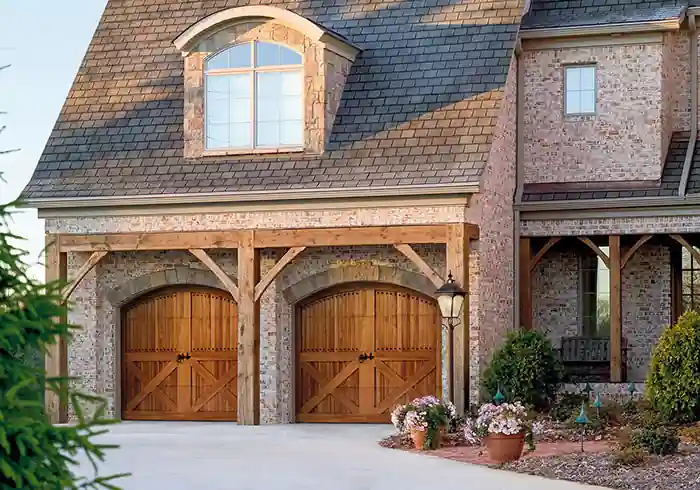
There’s something undeniably charming about carriage-style garage doors. That soft arch? The vintage flair? It instantly makes a home feel warmer, cozier, even a bit nostalgic. If you’re aiming for that farmhouse garage ideas look or something straight out of Cape Cod — arched trim is your ticket.
Emulating Historic Carriage Doors with Arched Trim
This style brings together function and fantasy:
- Curved upper trim pieces soften the square edges of most garage doors
- It’s often used with faux hinge straps, decorative clavos, or garage eyebrow trim
- Adds depth and texture to an otherwise flat garage door plane
Popular materials for arched trim include flexible PVC molding, wood (driftwood molding is a favorite), or even foam arch kits that mimic traditional woodgrain.
Pairing Trim with Arched Windows or Faux Hinges
Want that cohesive look? Coordinate your arched trim with:
- Arched garage windows (real or faux)
- Black angle iron hinge hardware
- A soft neutral or two-tone paint job (white trim on a pale gray or beige garage door works beautifully)
You’re essentially creating a garage door molding trim design that doesn’t just look good — it feels good.
Installation Challenges and Pro Tips
Arched trim isn’t plug-and-play like straight boards. But it’s absolutely doable with the right tools:
- Use flexible PVC or vinyl trim for gentle curves
- For tight curves, consider cutting multiple thin wood strips and bending them slowly
- Seal all joints with exterior-grade weather stripping and garage door draft stoppers
Installation Tools Checklist:
| Tool or Material | Purpose |
|---|---|
| Jig saw or oscillating multi-tool | Cutting precise curve ends |
| Heat gun (if using PVC) | Bending material into curves |
| Dual Flap Top Seal or clip-on seal | Seals top edges for weatherproofing |
| Colored Trim Nails + filler putty | Clean, painted finish |
Pro Tip: Match the arch height to the peak of your garage gable for architectural harmony. You don’t want it to look like it’s floating awkwardly in space.
6. Faux Stone or Brick Trim for a Luxurious Look
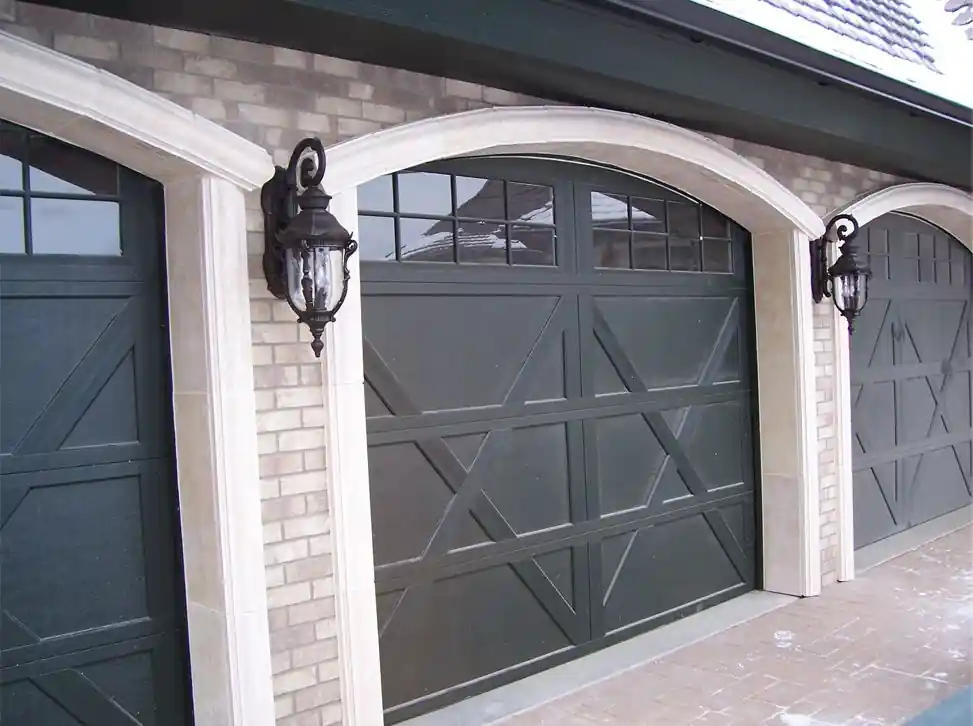
Now, let’s talk drama — the good kind. Adding faux stone or brick garage door molding trim takes your curb appeal to a whole new level. It feels upscale, custom, and frankly, like you hired a designer (even if you didn’t).
Materials for Stone-Look Trim
We’re not talking about hauling in bricks and mortar. Today’s stone-look trim is much more DIY-friendly. Here are a few common types:
- Faux stone panels – Lightweight polyurethane sheets that mimic real stone
- Stick-on brick veneers – Adhesive-backed, thin brick layers
- PVC stone wrap kits – Waterproof, textured, and great for wet climates
These options are popular in garage door molding trim kits at wholesale locations or big-box stores — even places like Kendall Center Yellow Garage use standard trim styles. Some kits, like those from Garage Buddy Halloween editions, even come pre-colored to match common siding or garage tones.
Design Tips to Blend with the House
When using faux materials, integration is key. You don’t want the garage to feel like an afterthought. So:
- Match the tone and texture to your siding or porch columns
- Use component brick mould and angle iron edges for a seamless transition
- Keep lines clean — especially where garage door track components meet the molding
This is also where garage style matters. If your home is Mediterranean, modern farmhouse, or traditional colonial, faux stone or brick can be adapted with the right materials and colors.
Installation Tips and Cost Considerations
DIY vs. Professional:
If you’re handy with measuring, sealing, and mounting panels — go DIY. Most kits include simple instructions and use mount applications like clips, adhesives, or screws.
Cost Breakdown (Average per linear foot):
| Material Type | DIY-Friendly | Cost/Linear Ft | Weatherproofing Needed? |
|---|---|---|---|
| Faux Stone Panel | Yes | $9–$15 | Optional (use caulk/sealants) |
| Stick-On Brick | Yes | $7–$12 | Required (to prevent water seepage) |
| PVC Stone Kit | Yes | $6–$10 | Built-in resistance |
Pro Tip: Install a garage door bottom threshold seal strip before adding stone trim. It keeps moisture out and ensures your new trim won’t warp or peel at the base.
7. Contrasting Color Trim: Bold Outlines That Pop
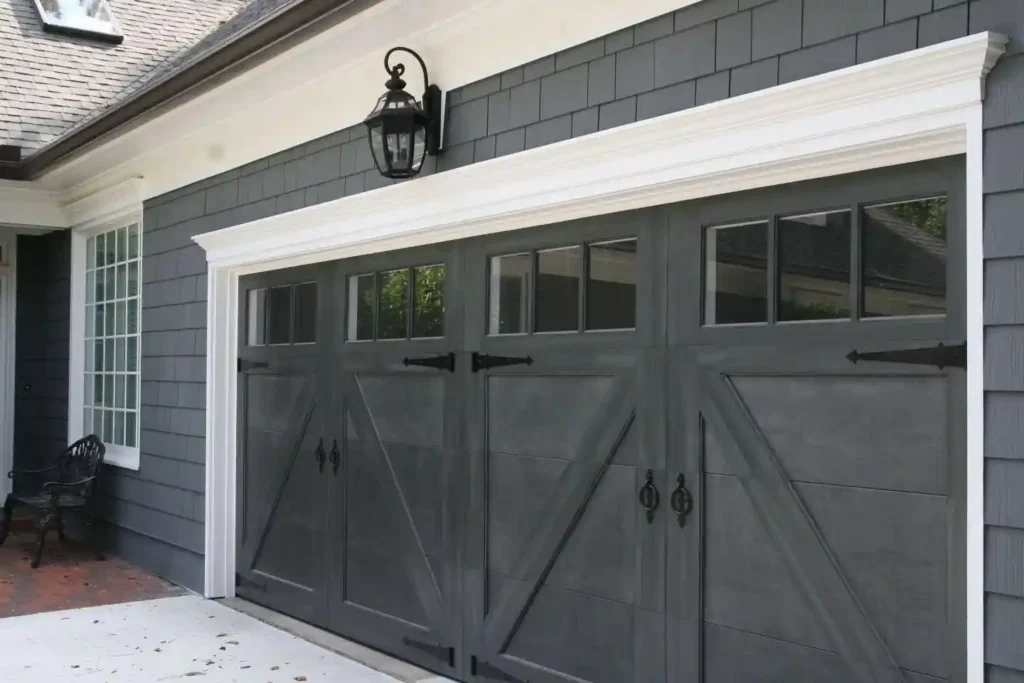
Want to make your garage door pop without replacing the whole thing? Paint might be your best friend. Contrasting garage door molding trim is one of the simplest, most affordable ways to instantly lift your curb appeal — and it’s surprisingly effective.
Using Color to Frame Your Garage Door
This isn’t about going wild with neons. It’s about using contrast strategically to add definition and character. For example:
- Black trim on white garage doors = Clean, modern, slightly dramatic
- Navy on light gray = Sophisticated and timeless
- Dark oak molding on tan or beige siding = Earthy and inviting
- Walnut molding with dark green siding = Classic rustic with a luxe twist
When done right, this approach can completely reshape how the garage sits within the façade — creating structure where there once was a blur. It’s ideal for both garage door molding trim replacement and fresh builds.
Painting Tips for Long-Lasting Finish
Color is only as good as its longevity. Here’s what you’ll need to make it last:
- Exterior primer suited for vinyl, wood, or PVC (depending on material)
- Sherwin Williams or equivalent high-end exterior paint
- Colored Trim Nails to blend with your paint for that seamless look
- Always sand and clean the trim before applying — even PVC should be lightly scuffed
Pro Tip: Use painter’s tape to create a razor-sharp edge where your trim meets the garage door — especially important if using bold colors.
What Colors Work Best Together?
If you’re feeling stuck, here’s a quick guide using basic design theory:
| Garage Door Color | Great Trim Pairings | Style Vibe |
|---|---|---|
| White | Black, Charcoal, Navy | Modern/Transitional |
| Gray | White, Walnut, Driftwood | Soft & Classic |
| Woodgrain | Dark Brown, Black, Beige | Warm & Rustic |
| Black | White, Bold Red, Bronze | Urban & Clean |
And don’t forget to use visualization tools (like Behr or Sherwin Williams online) to test your combos before buying paint. Some even offer augmented reality previews.
Conclusion:
Here’s the thing — upgrading your garage door molding trim doesn’t have to be a major remodel. In fact, most of the ideas we’ve covered can be done in a weekend, with just a few tools and a bit of inspiration.
From the timeless elegance of classic colonial trim to the bold outlines of contrasting color borders, each of these seven styles offers something a little different. Some, like modern minimalist trim, lean toward subtlety. Others, like arched carriage-style molding or faux stone applications, turn your garage into a standout feature.
But it’s not just about looks. Trim plays a functional role, too:
- It closes gaps in the garage door frame
- Helps with garage door weatherproofing
- Protects against pest entry and water damage
- Enhances energy efficiency with tight garage door seals
So ask yourself: What’s your home’s vibe? Cozy bungalow? Sleek modern? Classic craftsman?
Whichever you choose, remember that even small tweaks — like switching to PVC stop molding or adding a Garage Door Seal Bottom Seal — can have a big payoff. Style and function don’t have to be mutually exclusive.
Call to Action: Maybe this weekend’s the right time to finally give your garage some love. You don’t need a whole crew — just a vision, a trim kit, and a few Colored Trim Nails. Let it frame your home the way it deserves.
Frequently Asked Questions
1. What exactly is garage door molding trim?
It’s the framing around your garage door — usually made of wood, PVC, or composite — that makes the door look finished and seals the edges from weather.
2. Do I really need trim around my garage door?
Honestly, yes. It’s not just decorative. It helps protect the door opening from moisture, bugs, wind, and temperature swings.
3. Can I install garage door trim myself, or do I need a pro?
You can totally DIY it, especially with a garage door trim kit. Just make sure you measure correctly and seal any gaps. Some curved trims (like arched ones) might take more patience.
4. What’s the best material for garage door molding trim if I hate maintenance?
Go with low-maintenance PVC. It doesn’t rot, it’s paintable, and many versions include a built-in clip-on seal or come pre-textured to mimic wood.
5. My garage door has gaps on the sides. Can trim fix that?
Absolutely. You’ll want to combine garage door jamb trim with a universal adhesive backed garage door rubber seal strip or dual flap top seal to fully close it up.
6. Will new trim help lower my energy bills?
Surprisingly, yes — if it’s part of a good weather stripping and Garage Door Seal Bottom Seal setup. Those small drafts can add up over time.
7. Can I paint over existing trim, or should I replace it?
If your current trim isn’t damaged or warped, painting is fine. But if it’s old wood showing signs of rot or water damage, replacement is the better move.
8. What style of garage trim works with modern steel doors?
Stick with modern minimalist trim — flat, slim profiles with hidden fasteners. Use aluminum or composite materials that match the door’s color.
9. How do I make arched trim for a curved garage opening?
Use flexible PVC trim or create a custom arch from multiple thin wood strips. It takes a little time, but with the right tools (like a jig saw), it’s doable.
10. Where can I find these trim kits and weatherproofing pieces?
Most big-box stores have them, but for wider selections (especially decorative ones), try a wholesale location or specialty online shop. Look for brands offering options like Rigid Vinyl Reverse Angle Jamb Seals or Garage Door Draft Stopper systems.

